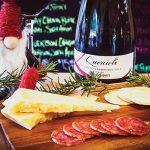
Treasures Under the Tree
The beginning of a beautiful friendship
By Bill Fields
There was an episode of The Waltons titled “The Best Christmas” in which mother Olivia is determined to have the merriest of holidays even without sipping a drop of the Baldwin sisters’ white lightning. She wanted her large brood all together for perhaps the last time, but her plans went awry because of a snowstorm, downed tree, car-in-a-pond and other misfortunes.
That show aired in 1976, but my best Christmas — still Santa-believing division — occurred seven years earlier.
As the turbulent 1960s came to a close, for me, a sports-loving 10-year-old, a door opened to what became my favorite sport and, to a larger degree, my life.
Up to that point I had batted around golf balls with a Kroydon putter and a Wilson 5-iron I talked my parents into buying on separate visits to the Sky City High Point. Those implements, though, didn’t make me a golfer like the ones I saw playing around town and on television or read about in the paper. In my mind, I needed a set of clubs for that to be so.
For my parents, those were tiring months leading up to Christmas 1969, because I brought up my desire for a set of golf clubs many times. A Mom and Dad with more Scrooge in them might have denied me, but they weren’t built that way.
Presents from Santa Claus weren’t wrapped in the Fields household, so when I came into the living room on Christmas morning and glimpsed something long and red on the floor with shiny things sticking out the top, I squealed with joy.
It was a Spalding “Tournament” starter set including a rectangular vinyl bag. The driver and 3-wood were made of “Persimmonite,” the Naugahyde of wooden clubs, and guarded by black covers. The irons were Nos. 3, 5, 7 and 9. There was a blade putter, which upon use and research I would discover was a cross between a club you’d find on a miniature-golf counter and Spalding’s venerable “Cash-In” model.
The clubs had Palmer’s signature on them — Johnny, not Arnold. I didn’t know who Johnny Palmer was, but his handwriting was neat, and since his name adorned a set that sold for about half of my dad’s weekly pay, he must be somebody special.
The grips were tacky rubber and the whole kit oozed opportunity. I removed each club out of the bag, took a grip — all fingers on the handle, having not discovered the overlapping style — and waggled above the carpet. Mom had a wide cautionary streak, but on this happy occasion I don’t think she warned me once about breaking a vase or marring the ceiling.
Frank Beard was the leading money winner on tour that year, but I don’t think his season was better than mine, thanks to the acquisition of my Spaldings.
Later on, I learned that John Cornelius Palmer Jr. was a fellow North Carolinian, born in 1918 in tiny Eldorado, the same birthplace as my grandfather Henderson. Johnny grew up in Badin and was one of the finest golfers to come out of the Old North State, winning seven times on the PGA Tour between 1946 and 1954. Twenty years before I found his name under our tree, Palmer finished second in the PGA Championship, tied for fourth at the Masters, and also was in the top-10 at the U.S. Open.
I used the Johnny Palmers for a couple of years, as my love for the game deepened, until graduating to a full set of used MacGregors purchased from Frank, a retiree I played with at Knollwood Fairways. The starter set was passed along to my father and subsequently to my brother-in-law Bob, an infrequent golfer.
The Spalding driver has been in my possession throughout adulthood. Only recently has the gang been back together, sans 3-wood, my sister digging the four irons out of a basement where her late husband had stored them, and shipping them from Oklahoma. I reclaimed the putter and bag when we cleaned out Mom’s house. I waggle them occasionally, the grips having slickened and hardened over time. The bag also holds my MacGregor woods, clubheads made of the real thing.
This fall I bought my first fresh sticks in about a decade. I was reminded there is nothing like a glossy new golf club, empty of errors and full of hope. But there is nothing like an old one either, especially when the nicks and scuffs are yours on a starter set that fulfilled its mission. PS
Southern Pines native Bill Fields, who writes about golf and other things, moved north in 1986 but hasn’t lost his accent.





